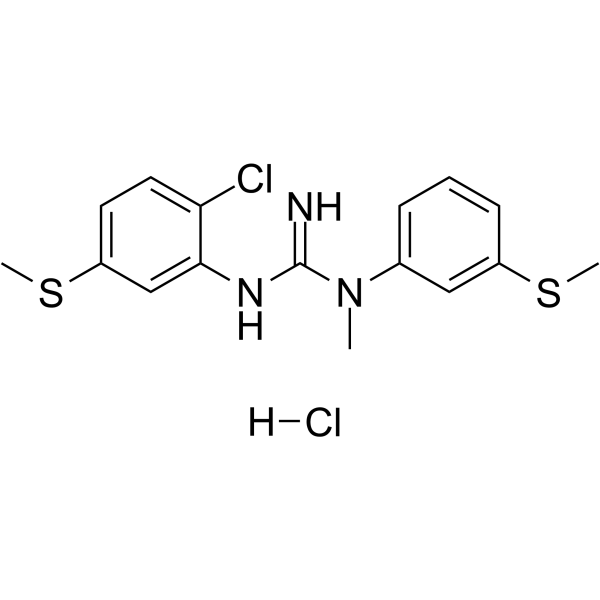
CNS-5161 hydrochloride
CAS No. 160756-38-7
CNS-5161 hydrochloride( CNS 5161A )
Catalog No. M26124 CAS No. 160756-38-7
CNS-5161 hydrochloride is a new antagonist of NMDA ion-channel. It interacts with the NMDA receptor/ion channel site to produce a noncompetitive blockade of the actions of glutamate.
Purity : >98% (HPLC)
 COA
COA
 Datasheet
Datasheet
 HNMR
HNMR
 HPLC
HPLC
 MSDS
MSDS
 Handing Instructions
Handing Instructions
| Size | Price / USD | Stock | Quantity |
| 5MG | 1512 | Get Quote |


|
| 10MG | 2043 | Get Quote |


|
| 25MG | 3033 | Get Quote |


|
| 50MG | 4077 | Get Quote |


|
| 100MG | 5517 | Get Quote |


|
| 200MG | Get Quote | Get Quote |


|
| 500MG | Get Quote | Get Quote |


|
| 1G | Get Quote | Get Quote |


|
Biological Information
-
Product NameCNS-5161 hydrochloride
-
NoteResearch use only, not for human use.
-
Brief DescriptionCNS-5161 hydrochloride is a new antagonist of NMDA ion-channel. It interacts with the NMDA receptor/ion channel site to produce a noncompetitive blockade of the actions of glutamate.
-
DescriptionCNS-5161 hydrochloride is a new antagonist of NMDA ion-channel. It interacts with the NMDA receptor/ion channel site to produce a noncompetitive blockade of the actions of glutamate.(In Vitro):CNS-5161 has potent inhibitory activity in vitro at the NMDA ion channel and is able to displace [3H] MK-801 binding with a Ki of 1.8 nM in synaptosomal membrane preparations from rat brain.(In Vivo):In the neonatal rat NMDA excitotoxicity model in vivo, CNS-5161 (i.p.) protects against the necrotic effects of exogenous N-methyl-D-aspartate (ED80: 4 mg/kg). CNS-5161 also shows a 91% inhibition of audiogenic seizures in DBA/2 mice at 4 mg/kg i.p. and has a neuroprotective effect following hypoxic/ischaemic brain injury in neonatal rats.
-
In VitroCNS-5161 (CNS 5161) is a novel and selective noncompetitive antagonist of the NMDA subset of glutamate receptors in the mammalian brain. CNS-5161 has potent inhibitory activity in vitro at the NMDA ion channel and is able to displace [3H] MK-801 binding with a Ki of 1.8 nM in synaptosomal membrane preparations from rat brain.
-
In VivoIn the neonatal rat NMDA excitotoxicity model in vivo, CNS-5161 (CNS 5161) protects against the necrotic effects of exogenous N-methyl-D-aspartate with an ED80 of 4 mg/kg by the intraperitoneal (i.p.) route. CNS-5161 also shows a 91% inhibition of audiogenic seizures in DBA/2 mice at 4 mg/kg i.p., and has a neuroprotective effect following hypoxix/ischaemic brain injury in neonatal rats.
-
SynonymsCNS 5161A
-
PathwayOthers
-
TargetOther Targets
-
RecptorBacterial| Parasite
-
Research Area——
-
Indication——
Chemical Information
-
CAS Number160756-38-7
-
Formula Weight388.37
-
Molecular FormulaC16H19Cl2N3S2
-
Purity>98% (HPLC)
-
Solubility——
-
SMILESCl.CSc1cccc(c1)N(C)C(=N)Nc1cc(SC)ccc1Cl
-
Chemical Name——
Shipping & Storage Information
-
Storage(-20℃)
-
ShippingWith Ice Pack
-
Stability≥ 2 years
Reference
1.Norlichexanthone isolated from fungus P16 promotes the secretion and expression of adiponectin in cultured ST-13 adipocytes. Med Chem. 2011 Jul;7(4):250-6.
molnova catalog



related products
-
Isoflurane
Isoflurane is a stable, non-explosive inhalation anesthetic that has been reported to induce caspase-3 activation.
-
Capryl caprate
Capryl caprate (Decanoic acid decyl ester) is a compound obtained from extracts of Tergite glands from the abdomen of virgin queen bees.
-
9-O-Acetyl-fargesol
9-O-Acetyl-fargesol is a natural product for research related to life sciences.



 Cart
Cart
 sales@molnova.com
sales@molnova.com


